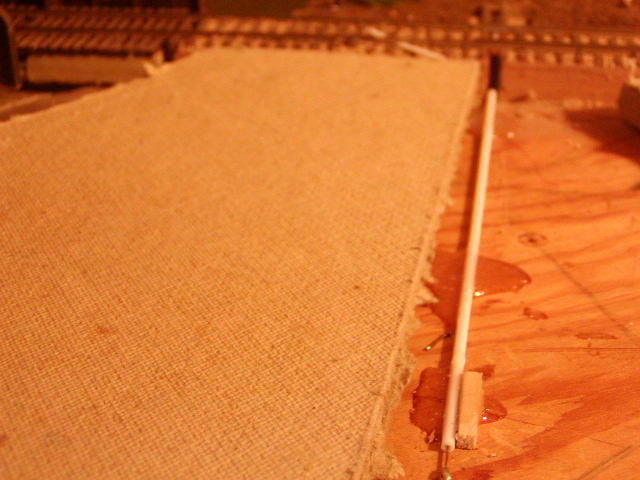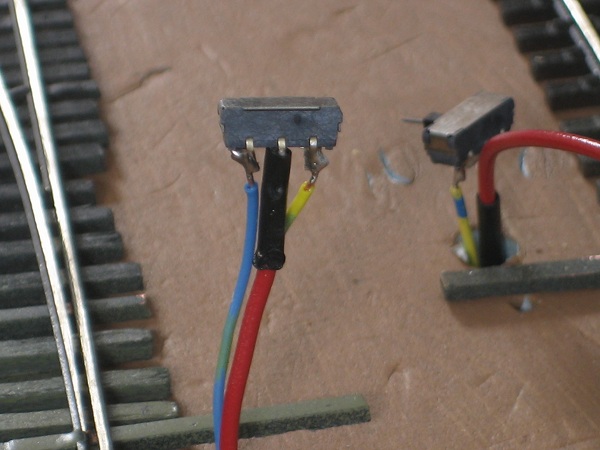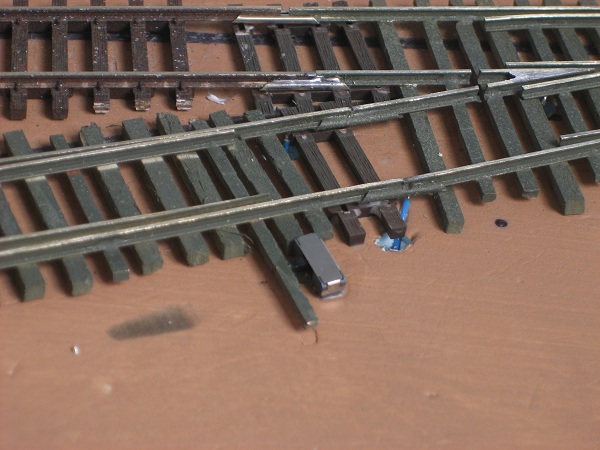Posts: 496
Threads: 22
Joined: Dec 2008
I had a situation where there was an obstruction beneath a turnout preventing me from using a motor beneath. My track is laid on 1/2" homasote, so I left a slot beneath the throwbar, and a length of 20 gauge copper wire which was soldered to the throwbar. I handlaid turnouts at that point in time. Many years passed before I recently completed this. Priot to that, I was able to pull or push the wire to throw the points, but I had the frog wired for the main route so I would get a short when metal wheels crossed the gap into the siding. I wasn't using it much! I finally decided to finish it, using a slide switch as I had planned. I slid a length of styrene tube over the 20 gauge wire to keep it from bending, and epoxied the tube to the plywood. The wire was not long enough to reach where I wanted teh switch, so I used some telescoping brass tube and solderd the wire inside. The tube in turn was pushed into a hole in the slide switch handle, a press fit reenforced with ca. You see a piece of homasote alonside this wire/tube contraption. There will be another on the other side, and a piece of .010 styrene sheet will bridge the gap, keeping future scenery out. I hope to use a flagpole as a handle, so far the only possibility for a flag I've found it a Microscale decal. Others are all printed flat and would look silly, imo.


Posts: 2,724
Threads: 160
Joined: Dec 2008
I had a similar idea to JGLfans... I posted it here <!-- l --><a class="postlink-local" href="http://www.the-gauge.net/forum/viewtopic.php?f=25&t=4311">viewtopic.php?f=25&t=4311</a><!-- l --> I have modified it slightly in the way that the switch connects to the throw bar as you can see here.

There is now a pin that goes horizontally through the switch into the throw bar. This way the connection is a little stronger. You can see it in the background of this shot. Also, the red wire is soldered to the frog and the yellow & blue wires are the + and - track power. This kind of switch control will work on either dc or dcc without any modification.

Here is a shot of the control that I was using earlier on, it is a modified version of a design by GaryS.

My other car is a locomotive, ARHS restoration crew
Posts: 1,210
Threads: 125
Joined: Dec 2008
This is how I have my yard set up using Atlas switch machines.
![[Image: 000_0052.jpg]](http://i21.photobucket.com/albums/b254/lesterperry/Misc/000_0052.jpg)
I have an old multimeter probe wired to touch the contacts where I want to go.
I use push push buttons elsewhere.
Posts: 2,269
Threads: 181
Joined: Dec 2008
To return to the original question, it seems that the answer is "whatever works best for you". Reading all of the modeling magazines, the first thing to note is tat this question has never been "solved" by anybody. Some of the most sophisticated layouts presented have mixtures of switch machines and manual turnouts, depending on location, personal preference and often simple workability.
Powered turnouts are all well and good, but each and every powered item on a layout is more challenge to Murphy's Law, which rules the known universe; i.e., if it can go wrong, it will - and it will do so at the worst possible moment.
My plan for my own layout is to use simple mechanical linkages for turnouts close to the front of the layout, and electrical ones for those on the far side. This makes sense to me because this keeps the mechanical linkages short and simple, and repairs relatively easy, while distant turnouts are more efficiently operated remotely. If it doesn't work out that way, I'm willing to sacrifice switch machines in the interest of better operation, because I know that the mechanical ones will always work, and the last thing that I need is a forest of electrical switches
I also derive personal satisfaction from "throwing the lever" myself, even if it's only a simple knob that shifts a set of points. It gives me a hands-on feel that just isn't there with an electrical switch.
Just my humble opinion.





![[Image: 000_0052.jpg]](http://i21.photobucket.com/albums/b254/lesterperry/Misc/000_0052.jpg)